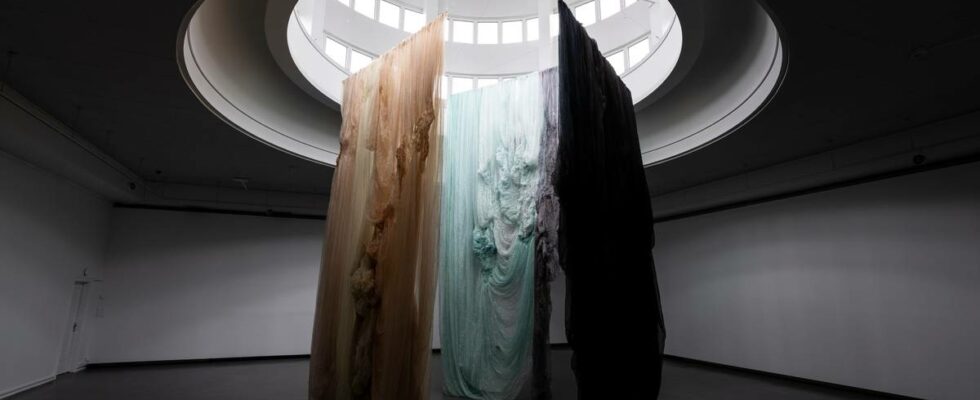One kilometer of fabric forms the starting point for the textile installation “Flood”, which now fills Tårnsalen at Kode. For over twenty years, Hanne Friis has distinguished herself with her sensuous works in the borderlands between textiles and sculpture. She has worked with everything from nylon and synthetic rubber to denim and silk. She has developed a completely unique technique where she folds the fabrics into small, fine pleats which she sews together with fishing line, so that a waffled or grooved surface is created. In this way, she creates powerful textile sculptures that are sometimes reminiscent of draperies and clothing, and at other times have an almost corporeal or underwater quality, like internal organs, or corals and conch shells. At first glance, the textiles look like a flowery waterfall of stone-washed silk falling from the ceiling to the floor. Photo: Thor Brødreskift The different textiles in “Flood” play in different shades of color and shine beautifully through each other. Photo: Thor Brødreskift The light from the skylight changes the mood. Sometimes the textiles will be full of sunshine, while at other times the installation will lie in pitch darkness, lit only by pale, gray rainy weather light. Photo: Thor Brødreskift Powerful mourning work My first encounter with Hanne Friis’s art was at Høvikodden in 2012, when she presented her powerful mourning work “Shades of blue” at the memorial exhibition for the 22 July terror. Here she had created a monumental textile sculpture, which at first glance looked like a flowery waterfall of stone-washed silk falling from the ceiling to the floor. In reality, the sculpture was quite lead-heavy and sewn from old woolen trousers. By using jeans, which are the very timeless symbol of youth, she created a poetic and brutal reflection about all the many young people we lost on that bad Friday in 2011. The work made an indelible impression on me, and since then I have followed this artistry with great interest . 22 JULY GRIEF WORK: Hanne Friis’s “Shades of blue and black” from 2012. A sculpture sewn together from tightly packed layers of denim fabric. Ola trousers in the entire blue tone spectrum. Photo: Øystein Thorvaldsen / HOK A spatial experience At Kode, Hanne Friis has created a spatial and almost architectural installation with three large textile elements that are mounted under the light dome in the tower hall. “Flood” is the name of the exhibition, and it is precisely a flood of materiality and light in various colors that she has created. She shows her competence when she matches the golden beige-brown sculpture against the black and the pale turquoise. A nice play of colors occurs here. FASCINATING INSTALLATION: I love how the installation catches the light. Hanne Friis strives for movement in expression. “Flood” is a good title. Especially in the green you get the feeling of a waterfall. Photo: Thor Brødreskift I like how the different fabrics shine through each other, how the beige has something intimately serge and silk stocking-like about it – while the black is not black at all when I get up close, but has beautiful blue and purple shadings in it. I also like how the turquoise green alternates between appearing like expensive silk and thinly worn green plastic. It makes me think of the kind of washed-up plastic that you often find littering the spring rocks. This is the strength of Friis’s project: the breaks between something natural and something artificial. That which appears as created and processed, and that which just is. The work, which is in golden beige tones, has something intimate about it, perhaps because the color is reminiscent of something like a nightgown or silk stocking. Photo: Thor Brødreskift Hanne Friis is at her best when she creates dense sculptures, where much of the material is transformed. But the break between the processed and the unprocessed textile is also an important part of the expression. Photo: Thor Brødreskift Here, the rich incidence of daylight plays an important role in the expression, which means that the installation is constantly changing throughout the day, and from day to day. Photo: Thor Brødreskift Something that doesn’t quite fall into place I’ve always liked the play in Friis’ sculptures between the dense, waffled stitched surfaces and the parts of the fabric that form free, unprocessed folds. I stand for a long time in this cascade of substances and light, pondering what is a little off for me this time, because there is something that doesn’t quite fall into place. Perhaps it is because these sculptures are so enormously large that there is a bit much of the raw material? RECOGNIZED TEXTILE ARTIST: Hanne Friis (b. 1972) is educated in painting and sculpture at the Art Academy in Trondheim. In recent decades, she has moved in an increasingly textile- and craft-based direction and distinguished herself with her sensuous works on the border between textile and sculpture. Photo: Jannik Abel I also think that the installation as a whole could have benefited from a variation in the assembly. As a color composition, it would create more tension if there were not exactly the same amount of each color, and if perhaps the elements were mounted a little higher. In this way, the viewer would not be so aware of the hanging itself, but get a feeling that the fabrics flowed freely out of the light up there. But all of this is basically just a quibble, a perfectionism in the face of an artist who has always impressed me, and who I therefore probably meet with almost unreasonable expectations. All in all, regardless, “Flood” was a powerful and wonderful experience that I wish everyone could have. news reviewer Photo: Øystein Thorvaldsen / KODE Title: “Hanne Friis: Flood” Curator: Heidi Bjørgan Institution: Lysverket, KODE Period: 25 May to 15 September 2024 Estimated time: 30 to 50 minutes Published 11.06.2024, at 06.00
ttn-69
“Flood” by Hanne Friis at Kode in Bergen – Reviews and recommendations

